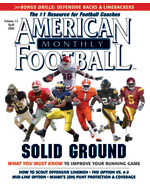AMERICAN FOOTBALL MONTHLY THE #1 RESOURCE FOR FOOTBALL COACHES
Article CategoriesAFM Magazine
|
How do you Scout your Opponents Offensive Lineby: Matt Fulks© More from this issue It always seems to work this way, things filtering down from the colleges to the high schools. As technology with digital editing has advanced and pro teams have become more intricate in their scouting, so, too, have colleges and high schools. One place that’s as prevalent as any other is picking apart your opponents’ offensive linemen. Anton Stewart, the defensive coordinator at Pittsburg State (KS), is among the growing number of coaches who closely scouts his opponents’ linemen each week, trying to find any advantage that might be there. Coaches look for anything from mismatches they can exploit to mismatches their opponent might try to use, to tips that individual linemen might give off through nuances or tendencies. “The biggest thing I look for is....The full article can only be seen by subscribers. Subscribe today!
|
|
|||||||
| HOME |
MAGAZINE |
SUBSCRIBE | ONLINE COLUMNISTS | COACHING VIDEOS |
Copyright 2025, AmericanFootballMonthly.com
All Rights Reserved





